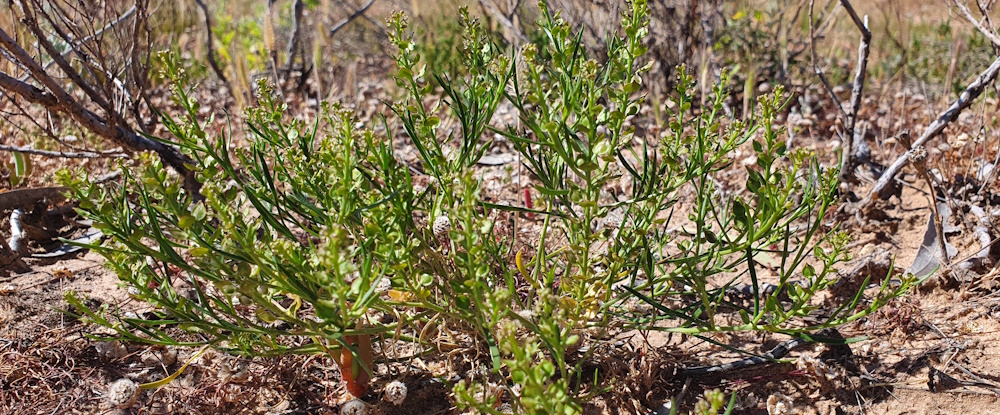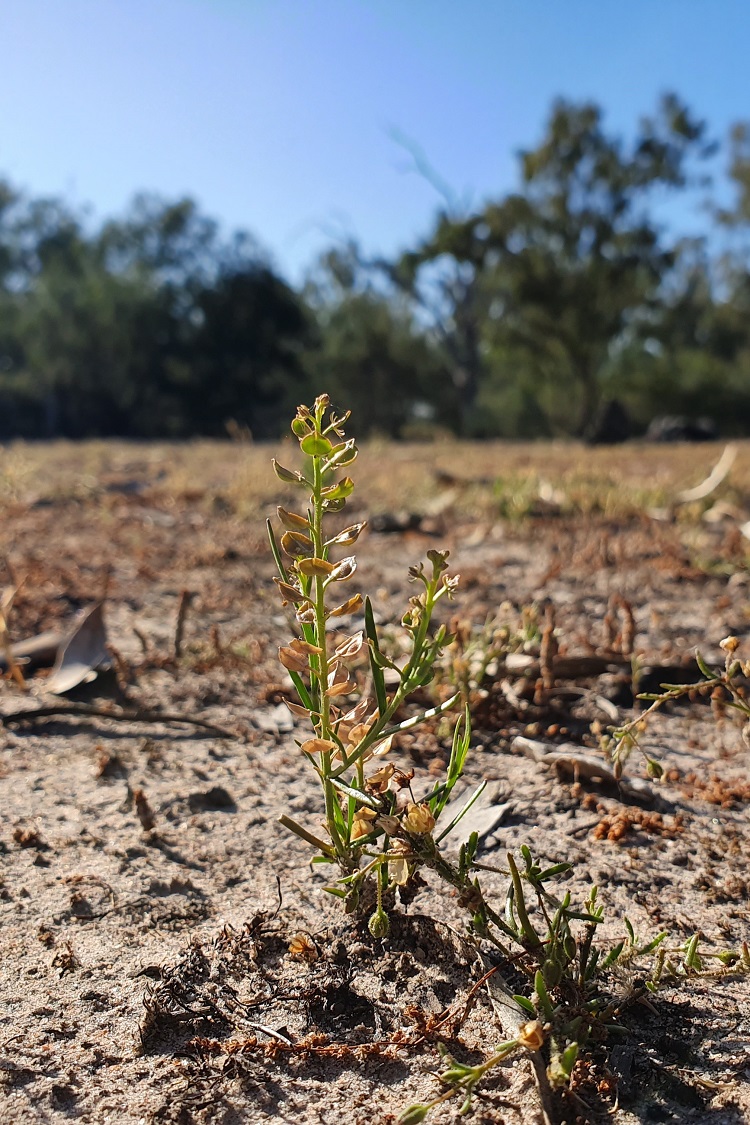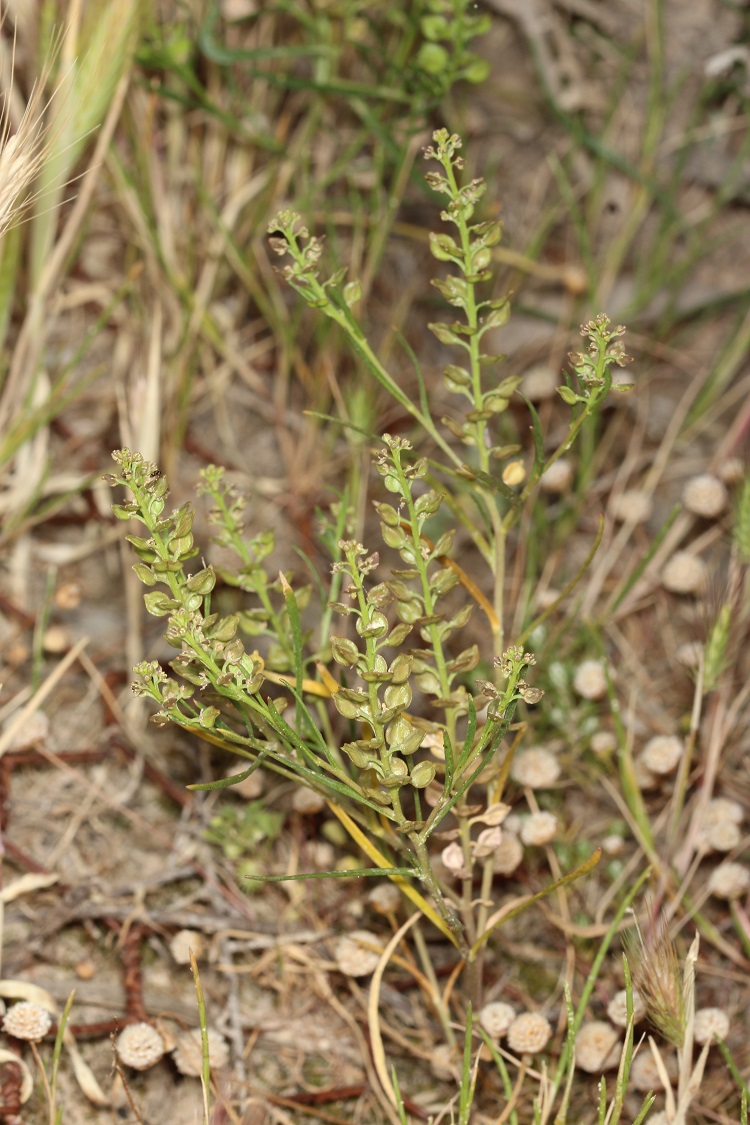In short
|

Photo credit: Claire Moxham
A poorly understood, inconspicuous species
Winged Peppercress (Lepidium monoplocoides) is an annual herb that is listed as Endangered both nationally and within Victoria. The species is short and inconspicuous with small, narrow leaves making it difficult to detect and identify. Plant germination and growth is triggered when moisture in the soil increases, usually after good rainfall or floods, hence their rarity and short-lived nature. Winged Peppercress occurs in a range of vegetation types on clay soils which retain a high moisture content, such as floodplains and dry lake beds.
Little is known about the ecology, habitat, threats and management needs of Winged Peppercress. This makes it difficult to develop appropriate management actions to protect the species. In addition, the species is becoming increasingly vulnerable as rainfall and floods become more variable and unpredictable. Long-term monitoring provides valuable insights into species ecology, habitat, population trends and management requirements that inform conservation actions.
Winged Peppercress was once widespread from north-central New South Wales (NSW) to western Victoria. But since European settlement, the population has declined due to several threats including grazing, land clearing, other human activities and changes to the flood regime. There are now only a few remnant populations scattered throughout NSW and Victoria.
What we did
ARI botanists have been monitoring Winged Peppercress populations at the Hattah Lakes Ramsar site since 2019. This population is considered critical for the survival and recovery of the species in Victoria. Our aim is to improve our understanding of Winged Peppercress ecology, population trends, environmental conditions and management. In spring each year, we assessed:
- the geographical range of the population
- the number of individuals and their life stage (e.g. juvenile, adult)
- signs of damage from a range of threats such as grazers, weeds, human activities and water availability.
An assessment of habitat preference was undertaken in 2019. This allowed us to target similar habitat in subsequent years when searching for new populations.

Photo credit: Claire Moxham
In spring 2022, Victoria experienced heavy rainfall and storms which led to major flooding at Hattah Lakes. While some plant species were negatively impacted, others like the Winged Peppercress can thrive. By comparing monitoring records from before and after the floods, we gained insights into how Winged Peppercress responded to the changing environment.
This monitoring program was funded by the Mallee Catchment Management Authority through the DEECA Victorians Waters Programs Investment Framework (VWPIF) in partnership with Parks Victoria.
Key findings:
- Winged Peppercress population at Hattah Lakes boomed following the 2022 floods. Compared to 2019, the population more than doubled and had a geographical range expansion. Plants were larger and had higher numbers of flowers and seed pods.
- At Hattah Lakes Winged Peppercress habitat preference includes low vegetation and litter cover, with high bare ground and soil crust cover. Plants often occur near and on the fringe of vegetation, on soils with a high clay content.
Key threats at this location include: grazing (introduced and native herbivores), weed invasion, rising salinity and soil disturbance (e.g. vehicles). - Two important ongoing management actions across Hattah Lakes include maintaining low browsing pressure and appropriate flooding regimes.
Research impact
ARI’s monitoring of Winged Peppercress at Hattah Lakes has:
- Determined habitat preference at this location.
- Started to fill key knowledge gaps on species ecology and demographics and population trends through annual monitoring.
Identified threats and management actions required to facilitate species recovery. - This threatened species data also feeds into various government decision making tools such as the Strategic Management Prospects (SMP) and Habitat Distribution Models (HDMs). These tools are used inform conservation management and emergency recovery actions like floods and fire.

Photo credit: Mike Duncan
How you can help
Long-term monitoring is critical to further our understanding of Winged Peppercress and informing recovery. You can help by reporting sightings of Winged Peppercress into the Victorian Biodiversity Atlas (VBA). The data you put in will help detect more populations, monitor existing populations and detect changes over time.
In fragile landscapes such as floodplain and wetland environments it is important to keep to tracks to minimise soil erosion and trampling of vegetation.
Publications
- Moxham, C., Duncan, M., & Kenny, S. A. (2025). Winged peppercress Lepidium monoplocoides population and habitat observations at Hattah-Kulkyne National Park, Victoria. The Victorian Naturalist 142: 4-12.
For more information contact Claire Moxham, claire.moxham@deeca.vic.gov.au or sally.kenny@deeca.vic.gov.au
Page last updated: 03/12/25